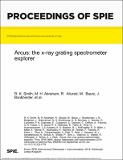| dc.contributor.author | Grant, Catherine E | |
| dc.contributor.author | Heilmann, Ralf K | |
| dc.contributor.author | Miller, Eric D | |
| dc.contributor.author | Bautz, Marshall W. | |
| dc.contributor.author | Huenemoerder, David P. | |
| dc.contributor.author | Nowak, Michael A. | |
| dc.contributor.author | Schattenburg, Mark Lee | |
| dc.contributor.author | Schulz, Norbert S. | |
| dc.date.accessioned | 2018-06-06T14:53:53Z | |
| dc.date.available | 2018-06-06T14:53:53Z | |
| dc.date.issued | 2016-06 | |
| dc.identifier.uri | http://hdl.handle.net/1721.1/116141 | |
| dc.description.abstract | Arcus will be proposed to the NASA Explorer program as a free-flying satellite mission that will enable high-resolution soft X-ray spectroscopy (8-50Å) with unprecedented sensitivity - effective areas of > 500 sq cm and spectral resolution > 2500. The Arcus key science goals are (1) to determine how baryons cycle in and out of galaxies by measuring the effects of structure formation imprinted upon the hot gas that is predicted to lie in extended halos around galaxies, groups, and clusters, (2) to determine how black holes influence their surroundings by tracing the propagation of out-flowing mass, energy and momentum from the vicinity of the black hole out to large scales and (3) to understand how accretion forms and evolves stars and circumstellar disks by observing hot infalling and outflowing gas in these systems. Arcus relies upon grazing-incidence silicon pore X-ray optics with the same 12m focal length (achieved using an extendable optical bench) that will be used for the ESA Athena mission. The focused X-rays from these optics will then be diffracted by high-efficiency off-plane reflection gratings that have already been demonstrated on sub-orbital rocket flights, imaging the results with flight-proven CCD detectors and electronics. The power and telemetry requirements on the spacecraft are modest. The majority of mission operations will not be complex, as most observations will be long (∼100 ksec), uninterrupted, and pre-planned, although there will be limited capabilities to observe targets of opportunity, such as tidal disruption events or supernovae with a 3-5 day turnaround. After the end of prime science, we plan to allow guest observations to maximize the science return of Arcus to the community. | en_US |
| dc.publisher | SPIE | en_US |
| dc.relation.isversionof | http://dx.doi.org/10.1117/12.2231778 | en_US |
| dc.rights | Article is made available in accordance with the publisher's policy and may be subject to US copyright law. Please refer to the publisher's site for terms of use. | en_US |
| dc.source | SPIE | en_US |
| dc.title | Arcus: the x-ray grating spectrometer explorer | en_US |
| dc.type | Article | en_US |
| dc.identifier.citation | Smith, R. K., et al. Arcus: "The x-Ray Grating Spectrometer Explorer." Proceedings Volume 9905, Space Telescopes and Instrumentation 2016: Ultraviolet to Gamma Ray, 26 June - 1 July, 2016, Ediburgh, United Kingdom, edited by Jan-Willem A. den Herder et al., SPIE, 2016, p. 99054M. © 2016 SPIE. | en_US |
| dc.contributor.department | MIT Kavli Institute for Astrophysics and Space Research | en_US |
| dc.contributor.mitauthor | Bautz, Marshall W | |
| dc.contributor.mitauthor | Grant, Catherine E | |
| dc.contributor.mitauthor | Heilmann, Ralf K | |
| dc.contributor.mitauthor | Huenemoerder, David P | |
| dc.contributor.mitauthor | Miller, Eric D | |
| dc.contributor.mitauthor | Nowak, Michael A | |
| dc.contributor.mitauthor | Schattenburg, Mark L | |
| dc.contributor.mitauthor | Schulz, Norbert S | |
| dc.relation.journal | Proceedings Volume 9905, Space Telescopes and Instrumentation 2016: Ultraviolet to Gamma Ray | en_US |
| dc.eprint.version | Final published version | en_US |
| dc.type.uri | http://purl.org/eprint/type/ConferencePaper | en_US |
| eprint.status | http://purl.org/eprint/status/NonPeerReviewed | en_US |
| dc.date.updated | 2018-03-16T13:54:46Z | |
| dspace.orderedauthors | Smith, R. K.; Abraham, M. H.; Allured, R.; Bautz, M.; Bookbinder, J.; Bregman, J. N.; Brenneman, L.; Brickhouse, N. S.; Burrows, D. N.; Burwitz, V.; Carvalho, R.; Cheimets, P. N.; Costantini, E.; Dawson, S.; DeRoo, C.; Falcone, A.; Foster, A. R.; Grant, C. E.; Heilmann, R. K.; Hertz, E.; Hine, B.; Huenemoerder, D.; Kaastra, J. S.; Madsen, K. K.; McEntaffer, R. L.; Miller, E. D.; Miller, J.; Morse, E.; Mushotzky, R.; Nandra, K.; Nowak, M.; Paerels, F.; Petre, R.; Plice, L.; Poppenhaeger, K.; Ptak, A.; Reid, P.; Sanders, J.; Schattenburg, M. L.; Schulz, N.; Smale, A.; Temi, P.; Valencic, L.; Walker, S.; Willingale, R.; Wilms, J.; Wolk, S. J. | en_US |
| dspace.embargo.terms | N | en_US |
| dc.identifier.orcid | https://orcid.org/0000-0002-1379-4482 | |
| dc.identifier.orcid | https://orcid.org/0000-0002-4737-1373 | |
| dc.identifier.orcid | https://orcid.org/0000-0001-9980-5295 | |
| dc.identifier.orcid | https://orcid.org/0000-0002-3031-2326 | |
| dc.identifier.orcid | https://orcid.org/0000-0001-6932-2612 | |
| mit.license | PUBLISHER_POLICY | en_US |
